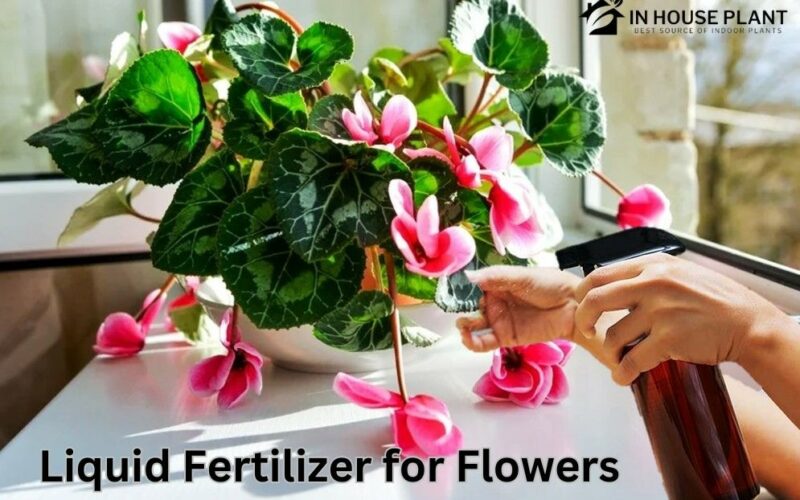To make flowers bloom, a proper diet with effective nutrients is vital. I find any low N ratio NPK fertilizer along with supplements such as seaweed-based fertilizers and Humic acids can work. Keep reading to tell you more details and facts about the best liquid fertilizer for flowers.
Hi, I’m a horticultural consultant who graduated in plant protection science. In this post, I want to share with you my knowledge and experience in feeding flowering plants and help you design a diet for them.
What Nutrient Makes Flowers Bloom?

People often ask me “What fertilizer makes my flowers bloom?”. I always tell them the best answer is in searching for “What nutrients make flowers bloom?”.
However, fertilizing (indeed, nutrients) is a factor of several factors that affect flowering (factors like the age of your plant, photoperiod, light intensity, temperature, oxygen, air circulation and humidity) and you must consider them too. Anyway, about fertilizing for blooming, I read lots of articles on how nutrients affect flowering. I found out that a deficiency of Macro and Micronutrients (such as N, P, K, Mg, Ca, S, B, Fe, Mn and Zn) can cause a delay in flowering.
Among the above nutrients, N, P, and K have been more investigated. In the following, I will tell you about the importance of some vital nutrients in flowering and then help you design a proper diet for your plant.
The Role of Nitrogen (N) in Flowering:
➡ Every action in a living matter such as flowering in plants is catalyzed by a kind of protein called Enzyme. N is a fundamental element in Proteins and enzymes’ structure. Hence, N deficiency will stop or decelerate every process in your plant including vegetative growth and flowering.
➡ Plants gain their required energy from sunlight through a process called Photosynthesize. This process is performed in the leaves. N is also a critical nutrient in the structure of Chlorophyll (a fundamental unit of Photosynthesize). Flowering needs a lot of energy. So, in N deficiency conditions, your plant cannot provide enough energy for flowering.
💡 However, a high amount of N will stimulate vegetative growth and delay blooming. It is a critical point to choose a fertilizer to make your flower bloom.
Hence you must consider a fertilizer which provides a low-to-moderate level (not deficiency) of N for your flowering plants.
The Role of Phosphorous (P) in Flowering:
In the previous part, I told you every action in your plant including flowering needs energy and plants gain it from the sun during the Photosynthesize process in their leaves. But how does this energy transfer throughout your plant and how do the plant cells use it?
➡ ATP plays the Energy Currency role in plant cells and P is a crucial element of ATP. Hence in P deficiency, your plant has a challenge in providing enough energy for flowering.
➡ In addition, cell division and synthesising of RNA and DNA are critical processes in the reproductive stage and P is a vital element in the structure of DNA and RNA.
Hence, Phosphorus deficiency causes lots of problems in making your flower bloom.
However, researches show a high level of P doesn’t induce early flowering and may impact the quality of flowers.
The Role of Potassium (K) in Flowering:
I discussed the importance of K for plants in my other post (The Best Liquid Fertilizer for indoor plants). K plays an important role in the activation of vital enzymes, enhancing the efficiency of N in the process of photosynthesizing, promoting nutrient absorption and making plants resistant to various stresses such as drought, pests, and diseases (like root rot), etc.
Research shows that increasing the level of K can affect the quality of flowers in some plants.
What is the Best Liquid Fertilizer for Flowers?

😯 Most gardeners believe feeding plants with high P fertilisers such as 10-52-10 induce flowers to bloom. However, as I told you above, the nutrient that can regulate the flowering time is Nitrogen, not phosphorus.
Ya-Ling Lin and Yi-Fang Tsay (2017) on Arabidopsis showed “A U-shaped flowering curve, with an optimal concentration of nitrate facilitating flowering and concentrations above or below this optimal concentration delaying flowering.”
So, fertilisers such as 10-52-10 stimulate plants to transfer from the vegetative to the reproductive stage by providing a moderate level of N for plants (not deficiency nor excessive level)
Hence, a plant diet including a fertilizer with a mild N concentration will make your flower bloom. In addition, other macronutrients such as P, K, and S and Micronutrients like Zn, Cu, B and Fe affect the quality and quantity of the flowers.
Based on the above information, I perform the following diet for my flowering plant however it can be a bite different for a special species. I only focus on liquid fertilizers because they are easy to use for houseplants.
|
Liquide Fertilizer to Make Flowers Bloom:
💡 After flowering I replace the first step with a 12-12-36 fertilizer to enhance the flower quality. |
- ➡ In addition, when my plant is confronted with stress, I add Amino acids to its diet to make it resistant.
- ➡ Please note that flowering is a short stage in your plant that gains much energy from it. Hence before stimulating flowers to bloom, try to make them strong by producing vigorous extended roots, big frequent leaves, and enhancing their overall health.
Conclusion
Two important points in flowering are regulating the time of blooming and enhancing the quality and quantity of blooms. Before making your plant bloom, ensure there isn’t any nutrient deficiency by soil and culture test (or monitoring nutrient deficiency). Fertilizing with a mild nitrogen level of an NPK liquid fertilizer will induce blooming. However, you should provide other macro and micronutrients (especially K, P, and Zn) with supplements such as a Seaweed-based fertilizer and Humic acids to enhance flower quality.
Please tell my readers and me about your experiences with the best liquid fertilizer for flowers and feeding them.

Elahe Rabiei
Hi, I’m Elaheh. My Academic major is plant protection, and houseplants are my expertise. As a houseplant lover, my house is full of indoor plants and it is my passion to take care of them. Hence, I’m here to share my knowledge and experience about growing healthy houseplants. I am also a plant protection advisor, so feel free to ask me any questions you may have.

